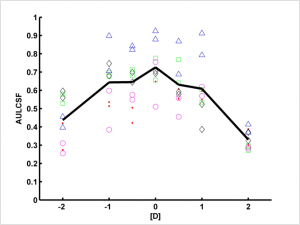Abstract
Purpose : Peripheral vision, as measured by the useful field of view test, is the best predictor of driving ability and crash risk and is superior to e.g. visual acuity and contrast sensitivity in the fovea. In addition, peripheral visual ability contributes to awareness, navigation and sports performance. Both neural and optical factors limit peripheral vision, by decreased density of ganglion cells and cones and through oblique astigmatism, coma and relative peripheral defocus. It is known that high contrast visual acuity (VA) is sampling limited and relatively insensitive to peripheral optical errors. However, VA is mostly indicative of reading ability, and typical peripheral tasks involve objects with lower contrast. In this study, through focus contrast sensitivity functions (CSF) in the periphery was measured.
Methods : A monocular adaptive optics visual simulator was used to measure contrast sensitivity in the 25 degrees temporal field of the right eye of five subjects with age of 31±6 years. Astigmatism was corrected and defocus induced with a Badal stage at 0, ± 0.5, ±1 and ±2 D. We used a quick-CSF procedure adapted for peripheral vision with 100 trials and two measurements for each subject at each defocus value. The peripheral CSF was quantified into a single value using the area under the log CSF (AULCSF).
Results : The through-focus AULCSF results is depicted in Figure 1. The intra-subject variability was a standard deviation of 0.05 AULCSF whereas the inter-subject standard deviation was 0.11 AULCSF. The impact of defocus on peripheral vision was larger for larger errors: when going from an absolute error of 1 to 2 D the average loss was 0.24 AULCSF whereas the average loss from 0 to 1 D was only 0.1 AULCSF.
Conclusions : Peripheral contrast sensitivity suffers a marked decrease with large optical errors. Increasing defocus from 1 to 2 D results in a loss of 38% of the remaining AULCSF. Conversely, going from 0 to 1 D only decreases the AULCSF by 14%. This might be due to a depth of focus induced by higher order aberrations as well as the best focus being at another position than what Zernike-based refraction metrics indicate. These results show the importance of not having too large peripheral optical errors that could affect driving safety.
This is an abstract that was submitted for the 2016 ARVO Annual Meeting, held in Seattle, Wash., May 1-5, 2016.


